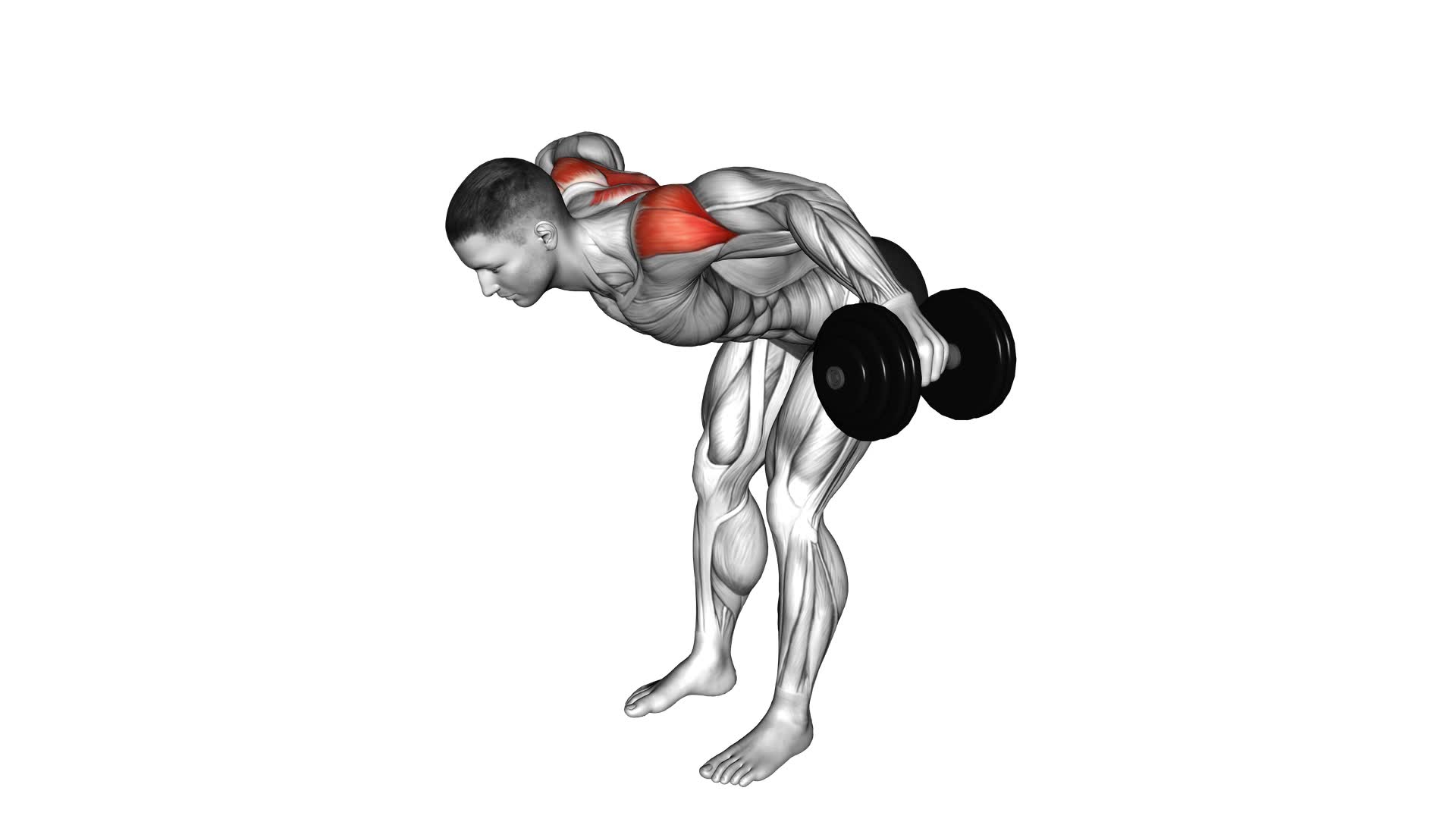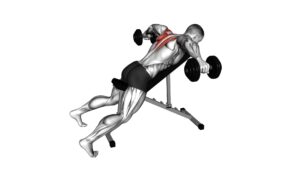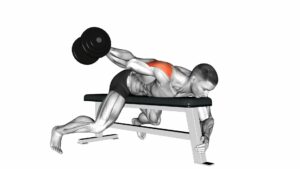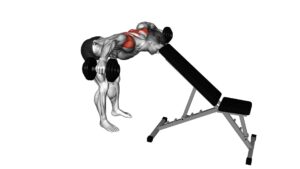Dumbbell Rear Lateral Raise – Video Exercise Guide & Tips

Looking to tone and strengthen your shoulder muscles? Then the dumbbell rear lateral raise is the exercise for you! In this video exercise guide, we'll show you the proper form and technique to maximize your results.
Watch This Exercise Video
Whether you're a beginner or advanced, we've got variations to suit your fitness level. Plus, we'll share tips to help you achieve maximum gains and common mistakes to avoid.
Get ready to sculpt those shoulders and feel the burn! Let's get started!
Key Takeaways
- Targets and strengthens rear deltoid muscles
- Focuses on the posterior aspect of the shoulder
- Provides resistance for muscle growth and strength
- Improves shoulder stability and prevents injuries
Benefits of Dumbbell Rear Lateral Raise
One benefit of performing the dumbbell rear lateral raise is that it targets and strengthens your rear deltoid muscles. This exercise specifically focuses on the posterior aspect of your shoulder, helping to develop more defined and stronger deltoids. When you perform the dumbbell rear lateral raise, you activate the muscles in your shoulder region, particularly the rear deltoids. By using dumbbells, you provide resistance that challenges your muscles and promotes muscle growth and strength.
Another benefit of this exercise is that it improves shoulder stability. As you lift the dumbbells to the side, you engage the muscles responsible for stabilizing your shoulder joint. This helps to enhance overall shoulder stability, which is crucial for preventing injuries and maintaining proper posture during various activities.
To maximize the benefits of the dumbbell rear lateral raise, it's important to focus on proper form and technique. Start with lighter weights and gradually increase the resistance as you become more comfortable and stronger. Keep your core engaged and maintain a slight bend in your elbows throughout the movement. Avoid swinging your body or using momentum to lift the weights, as this can diminish the effectiveness of the exercise.
Proper Form and Technique
To perform the dumbbell rear lateral raise with proper form and technique, it's important to consistently engage your core, maintain a slight bend in your elbows, and avoid swinging or using momentum to lift the weights. By engaging your core, you create stability and protect your lower back during the exercise. This is crucial to maintain proper form and prevent injury.
Additionally, keeping a slight bend in your elbows throughout the movement helps to isolate and target the muscles of the rear delts (posterior deltoids) more effectively. It ensures that the tension remains on the targeted muscles rather than being transferred to other muscle groups.
One common error to avoid is swinging the weights or using momentum to lift them. This not only diminishes the effectiveness of the exercise but also increases the risk of injury. Instead, focus on using controlled movements, lifting the weights in a slow and controlled manner. This will maximize the muscle activation and provide a greater challenge to the targeted muscles.
Muscle activation is a key aspect of performing the dumbbell rear lateral raise correctly. By maintaining proper form and technique, you primarily engage the rear delts, which are responsible for shoulder extension and lateral rotation. These muscles play a crucial role in shoulder stability and posture. It's important to note that the rear delts are a relatively small muscle group, so it's essential to use lighter weights and focus on proper form to effectively target and activate these muscles.
Variation of Dumbbell Rear Lateral Raise
Try the bent-over dumbbell rear lateral raise to target your rear delts from a different angle. This variation of the exercise involves bending over at the waist with a slight bend in your knees. Hold a pair of dumbbells with an overhand grip, palms facing towards your body. Keep your back straight and your core engaged throughout the movement. From this position, raise your arms out to the sides, keeping a slight bend in your elbows, until they're parallel to the ground. Squeeze your shoulder blades together at the top of the movement before slowly lowering the weights back down.
The bent-over dumbbell rear lateral raise is a great way to add variety to your shoulder workout and specifically target your rear delts. By changing the grip to an overhand position, you engage your muscles in a different way, leading to increased strength and muscle development.
If you're looking for alternative exercises to target your rear delts, you can try cable rear delt flyes or reverse pec deck flyes. Both exercises provide a similar movement pattern and effectively isolate the rear delts. Remember to focus on proper form and technique to maximize the benefits of these exercises.
Tips for Maximum Results
To maximize your results, use the correct form and technique while performing the dumbbell rear lateral raise exercise. Here are three tips to help you achieve the best possible outcome:
- Focus on your posture:
Maintaining proper posture is crucial during the dumbbell rear lateral raise. Stand with your feet shoulder-width apart, keep your back straight, and engage your core muscles. Avoid leaning forward or arching your back, as this can put unnecessary strain on your lower back.
- Use a controlled motion:
Rather than swinging the dumbbells up and down, focus on controlled movements. Lift the dumbbells out to the sides, leading with your elbows, until they're parallel to the ground. Slowly lower them back down to the starting position. This controlled motion ensures that you're effectively targeting your rear deltoids and minimizing the involvement of other muscles.
- Incorporate progressive overload:
To see continuous progress, gradually increase the weight of the dumbbells over time. This progressive overload stimulates muscle growth and strength development. Start with a weight that's challenging but manageable, and as you become stronger, gradually increase the load. However, remember to prioritize proper form and technique over lifting heavy weights.
Contrary to common misconceptions, the best time to perform the dumbbell rear lateral raise exercise is during your shoulder or upper body workout. This allows you to fully focus on targeting the rear deltoids and avoid overworking these muscles on other training days.
Incorporate these tips into your routine and watch your results soar.
Common Mistakes to Avoid
Maintaining proper form and technique is essential to avoid common mistakes while performing the dumbbell rear lateral raise exercise. One of the most common mistakes is improper shoulder alignment. It's crucial to keep your shoulders down and back throughout the movement. Avoid hunching your shoulders forward, as this can put unnecessary strain on your neck and upper back. To maintain proper alignment, imagine squeezing your shoulder blades together as you lift the dumbbells to the sides.
Another mistake to avoid is using momentum instead of relying on the strength of your muscles. Slow and controlled movements are key to effectively targeting the rear deltoid muscles. Avoid swinging the weights or using other body parts to assist with the lift. Instead, focus on engaging the target muscles and lifting the dumbbells with control. This will maximize the effectiveness of the exercise and minimize the risk of injury.
Frequently Asked Questions
How Many Sets and Reps Should I Do for the Dumbbell Rear Lateral Raise?
To determine how many sets and reps you should do for the dumbbell rear lateral raise, consider the benefits of this exercise.
The dumbbell rear lateral raise targets your rear deltoids, helping to strengthen and tone your shoulders. It also improves your posture and stability.
As for variations, you can try performing the exercise with a resistance band or using a cable machine.
Now, let's delve into the recommended sets and reps for optimal results.
Can I Perform the Dumbbell Rear Lateral Raise With Resistance Bands Instead of Dumbbells?
Yes, you can perform the dumbbell rear lateral raise with resistance bands instead of dumbbells. Using resistance bands for this exercise can provide several benefits.
Resistance bands offer variable resistance throughout the movement, helping to strengthen and tone your shoulder muscles. They also allow for a greater range of motion and can be more joint-friendly compared to dumbbells.
Incorporating resistance bands into your shoulder workouts can add variety and challenge to your routine.
Is the Dumbbell Rear Lateral Raise Suitable for Beginners?
The dumbbell rear lateral raise can be suitable for beginners with proper form and technique.
To perform this exercise, stand with your feet shoulder-width apart, holding dumbbells in each hand.
Bend your knees slightly and hinge forward at the hips. Keep your back straight and raise the dumbbells out to the sides, squeezing your shoulder blades together.
For beginners, start with lighter weights and focus on maintaining proper form.
As you progress, you can increase the weight and repetitions to challenge yourself.
Should I Perform the Exercise Seated or Standing?
Seated or standing, which is better for the dumbbell rear lateral raise? Well, it depends on your goals and preferences.
When you perform the exercise seated, you have more stability and can focus on isolating your rear delts.
On the other hand, doing it standing engages your core and stabilizer muscles more, making it a more challenging and dynamic movement.
Ultimately, choose the position that allows you to maintain proper form and achieve your desired results.
Can I Incorporate the Dumbbell Rear Lateral Raise Into a Full-Body Workout Routine?
Incorporating the dumbbell rear lateral raise in a full-body workout routine can be highly beneficial for overall muscle development. This exercise primarily targets the rear deltoids, which helps improve shoulder stability and posture. Additionally, it engages the traps, rhomboids, and upper back muscles.
Performing this exercise standing or seated allows you to target different muscle groups and modify the intensity. Including the dumbbell rear lateral raise in your workout routine can enhance your upper body strength and aesthetics.
Conclusion
In conclusion, the dumbbell rear lateral raise is a highly effective exercise for targeting the muscles in your shoulders and upper back. By performing the exercise with proper form and technique, you can maximize your results and avoid common mistakes.
With variations available, you can customize your workout to meet your specific fitness goals. Remember to start with lighter weights and gradually increase the intensity as you progress.
Incorporating this exercise into your routine can help improve your overall strength and posture.

Author
Years ago, the spark of my life’s passion ignited in my mind the moment I stepped into the local gym for the first time. The inaugural bead of perspiration, the initial endeavor, the very first surge of endorphins, and a sense of pride that washed over me post-workout marked the beginning of my deep-seated interest in strength sports, fitness, and sports nutrition. This very curiosity blossomed rapidly into a profound fascination, propelling me to earn a Master’s degree in Physical Education from the Academy of Physical Education in Krakow, followed by a Sports Manager diploma from the Jagiellonian University. My journey of growth led me to gain more specialized qualifications, such as being a certified personal trainer with a focus on sports dietetics, a lifeguard, and an instructor for wellness and corrective gymnastics. Theoretical knowledge paired seamlessly with practical experience, reinforcing my belief that the transformation of individuals under my guidance was also a reflection of my personal growth. This belief holds true even today. Each day, I strive to push the boundaries and explore new realms. These realms gently elevate me to greater heights. The unique combination of passion for my field and the continuous quest for growth fuels my drive to break new ground.







